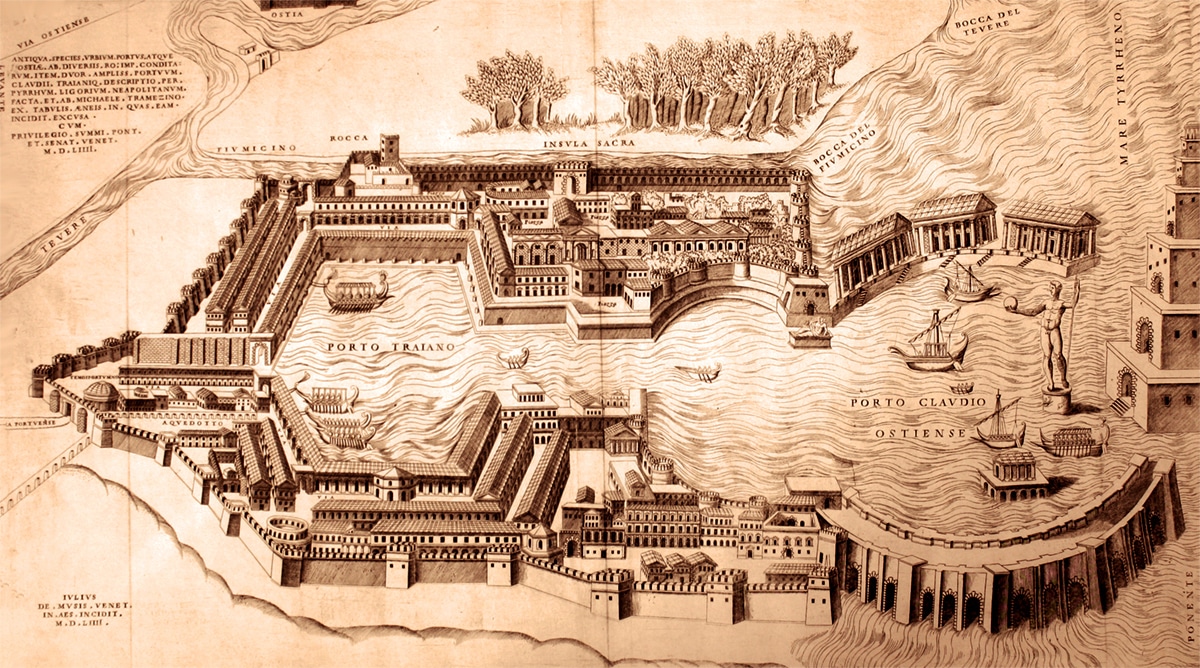Fiumicino, columns on the sea revealed the ancient Portus
The sight must have been really impressive for those who came from the sea. As the ships approached the docks, was now seen as a monumental great. It had an area of about three acres, and rose up to three floors. The imposing building sported long arcades driven by double rows of columns, for their height, created the evocative effects of reflection on the water. But it is only a detail of facade because within this architectural jewel signed, who knows, perhaps by Apollodorus of Damascus ( the archistars beloved Emperor Trajan ) revealed areas covered with polychrome marble floors decorated with mosaics, and roofs with vaulted ceilings . Each of the first two floors had its own system of latrines, while the ground floor stands the large cistern.
THE RUINS
Here is revealed the Imperial Palace of the ancient city of Porto (Fiumicino) , settlement port wanted by the emperors Claudius and Trajan (I- II century AD) , built north of Ostia , on the Tyrrhenian coast , on the right bank of the Tiber. The new port , after that of Ostia , in the service of Rome. The reconstruction of the Imperial Palace is the result of the discoveries the result of the excavations of the past two years directed by Simon Keay of the University of Southampton, thanks to the agreement with the Superintendence of Cultural Heritage . The new surveys of the harbor of Claudius and Trajan were presented yesterday at the British School at Rome by Professor Keay , Lidia Paroli opportunity to remind the Superintendent, recently deceased , who was responsible in 1990 shooting of a systematic study of Porto (city which extended to 60 acres, as Pompei) after almost a century . The investigations were concentrated in an area specified in Porto , between the dock of the port of Claudius and the north- west of the hexagonal basin built by Trajan between 100 and 112 AD in the rearmost position. The findings, under the scientific responsibility of Angelo Pellegrino in 2012, and Renato Sebastiani in 2013 , have provided new evidence that today many more characters reveal the morphology of the Imperial Palace, which remained in use until the fifth century when it was converted into fortifications protection of the harbor during the wars greek -Gothic style.
SYSTEM OF CORRIDORS
A resurgence has been a system of corridors with a vaulted ceiling with a scale that allowed to ascend to the first and second floor of the palace. Corridors that housed latrines and still keep the polychrome mosaic floors , and that stand to be achieved within a peristyle above the tank on the ground floor . An architecture that is compared with the peristyle of the Great Baths of Villa Adrian . “The last campaigns have made it clear that the Imperial Palace was demolished by the Byzantines , along with other edificinella first half of the sixth century ,” said Keay .
SAINTS
A witness to the historical evolution of Porto have also been investigations into the paleo -Christian basilica , the monument built on the structures of the warehouses that , until the end of the third century had functioned as storage of goods near the hexagonal port of Trajan. The studies, which will be presented tomorrow at Palazzo Massimo , reveal the transformation of a monument with three naves , apse completed in the fifth century . A basilica , destined to become bishop in late antiquity , which stands in the commercial heart of the ancient city , of which ” recycles ” the black and white mosaic floors . What makes it unique is the preservation of the original liturgical fences and the ambo . The basilica ( 40 meters long ) sports a baptismal font , floors of marble and fragments of painted plaster found on the collapses of the arches separating the nave . Among them, figurative types of saints of the twelfth century, without regard to Rome. Free tours in Porto, by appointment only ( 066 529 192 ).
LIKE OUR PAGE ON FACEBOOK

